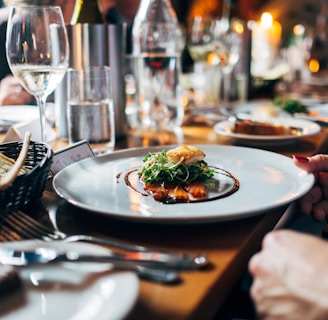Polishing Your Presence: Mastering Email Etiquette and Dining Manners in Today's Social World
5/2/20253 min read


Polishing Your Presence: Mastering Email Etiquette and Dining Manners in Today's Social World
In today's interconnected world, both digital communication and in-person interactions hold significant weight in shaping personal and professional impressions. Mastering email etiquette and dining manners – seemingly small details – can substantially impact how others perceive you, opening doors to opportunities and strengthening relationships. This post offers guidance and encouragement to refine these essential skills, empowering you to present your best self in every situation.
Email Etiquette: A Foundation for Effective Communication
Subject Lines: Clear and Concise: A well-crafted subject line is crucial. It should accurately reflect the email's content and purpose, making it easy for the recipient to prioritize and understand the message at a glance. Avoid vague or overly long subject lines. Instead, opt for clarity and brevity. For example, instead of "Question," try "Project X – Deadline extension request."
Professional Salutations and Closings: Always begin with a professional salutation, such as "Dear Mr./Ms./Mx. [Last Name]," or "Dear [First Name]," if you have an established, informal relationship. Avoid overly casual greetings like "Hey" or "Yo." Similarly, choose a professional closing such as "Sincerely," "Regards," or "Best regards," depending on the context. Ending with just your name provides a polished and confident finish.
Formal Tone and Language: Maintain a formal and respectful tone throughout your email. Avoid slang, jargon, or overly emotional language. Proofread carefully for grammatical errors and typos. A well-written email demonstrates attention to detail and professionalism, which are highly valued traits.
Concise and Organized Writing: Get straight to the point. Use clear and concise language, avoiding unnecessary wordiness. Organize your message logically, using paragraphs and bullet points where appropriate to enhance readability.
Appropriate Attachments: Ensure all attachments are relevant and properly labeled. Verify the file size to prevent delays or delivery issues. Inform the recipient if you're sending large files.
Prompt and Courteous Responses: Respond to emails promptly and courteously, especially those requiring immediate action. Acknowledge receipt of important emails, even if you need time to formulate a detailed response. A brief "Received and will respond shortly" shows professionalism and consideration.
Respecting Privacy: Be mindful of confidential information and avoid forwarding emails without permission. Use caution when sending sensitive data, and consider encrypting such emails for extra security.
Email Signature: Develop a professional email signature that includes your full name, title, company, and contact information. Keep it concise and consistent across all your communications.
Multiple Recipients: Use the "BCC" field when sending emails to multiple recipients to protect their privacy and avoid unnecessary reply chains.
Dining Manners: Grace and Confidence at the Table
RSVP Promptly: Responding promptly to invitations shows respect for the host's time and planning. Let them know your availability as soon as possible.
Punctuality is Key: Arrive on time for any dining event. Being late disrupts the flow and can be considered disrespectful to the host and other guests.
Proper Posture and Table Etiquette: Sit upright with good posture. Avoid slouching or leaning on the table. Keep your elbows off the table while eating.
Napkin Usage: Place your napkin on your lap as soon as you're seated. Use it to gently dab your mouth, avoiding excessive wiping.
Utensil Usage: Use utensils from the outside in, working your way inward with each course. If unsure, observe the host or other guests.
Conversation and Engagement: Participate in polite conversation, engaging with your fellow diners. Avoid dominating the conversation or discussing controversial topics.
Cell Phone Etiquette: Silence your cell phone before sitting down. Avoid checking it during the meal unless absolutely necessary.
Respectful Interactions: Be respectful towards the waitstaff and treat them courteously. Show gratitude for their service.
Gracious Exit: Thank the host for their hospitality before departing. A sincere expression of gratitude is always appreciated.
Handling Unexpected Situations: Be prepared to handle unexpected situations gracefully, such as spills or accidental breaches of etiquette. A calm and polite response will make the situation much easier to manage.
Cultivating Self-Improvement: A Journey, Not a Race
Mastering email etiquette and dining manners requires consistent effort and practice. Start by focusing on one or two areas at a time, gradually incorporating more refined practices into your daily routines. Don't be afraid to make mistakes; learning from them is a crucial part of the process. Each improvement, however small, contributes to a more polished and confident presentation of yourself.
Remember, the goal is not perfection, but continuous self-improvement. By striving to refine your communication skills and table manners, you demonstrate respect for others and enhance your overall image, creating a positive and lasting impression in both professional and social settings.
Questions to Spark Discussion:
What specific aspect of email etiquette or dining manners are you currently working on improving?
What challenges have you encountered, and how have you overcome them?
What resources or strategies have you found helpful in refining your social skills?
What are some unexpected situations you've experienced during a formal dinner, and how did you handle them? Share your tips!
What are some personal tips you can offer to those looking to enhance their social graces?
About us
Elevate your mindset and embrace personal growth.
Connect
Engage
hello@ignitesigma.com
+1-323-603-6416
© 2025. All rights reserved.